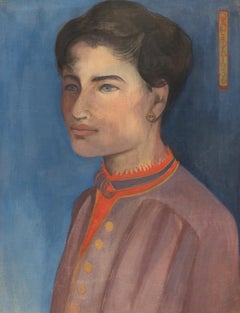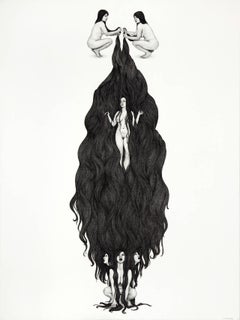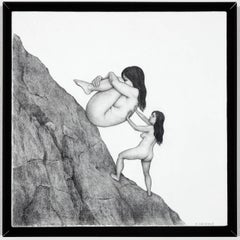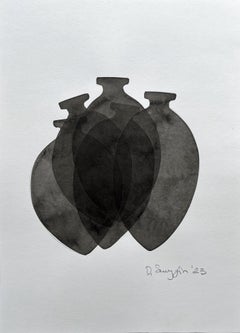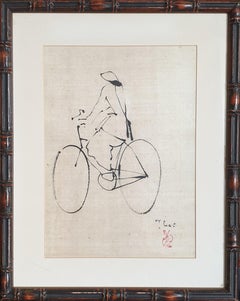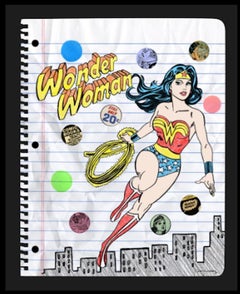Linen Figurative Drawings and Watercolors
to
1
5
2
2
1
4
2
1
1
2
4
Overall Height
to
Overall Width
to
4
1
6
5
4
3
2
1
1
1
1
1
1
1
2
4
1
3
1
10,455
6,213
5,902
5,372
4,340
Medium: Linen
Portrait of a Woman by Orovida Pissarro - Portrait painting
Located in London, GB
Portrait of a Woman by Orovida Pissarro (1893-1968)
Egg tempera on silk laid down on stretched linen
47.6 x 37 cm (18 ³/₄ x 14 ⁵/₈ inches)
Signed and dated upper right, OROVIDA 1936
Provenance: Christie's London, 1985
Kunstgalerij De Vuyst, Belgium
Private collection, London
Private collection, London, by descent
Artist biography:
Orovida Camille Pissarro...
Category
1930s Linen Figurative Drawings and Watercolors
Materials
Linen, Egg Tempera
'Dans le creux de la vague #4, ' by Josette Simon-Gestin, Acrylic Painting
Located in Oklahoma City, OK
This 38" x 46" acrylic on linen on canvas painting by French artist Josette Simon-Gestin depicts a pleasant and serene summer scene of two girls playing alongside a lush blue-green p...
Category
2010s Contemporary Linen Figurative Drawings and Watercolors
Materials
Linen, Acrylic
"Love and Lotus Boys, " Ink on Linen Panels, 1850
Located in Chicago, IL
Drawn with a fine line and fresh, sketched quality, this folk hanging unites two scenes of lucky hoho lotus boys circumscribed in frames punctuated with fruits such as pomegranate, symbolic of prosperity and good fortune. On top, the two explore the natural wonders of the world...
Category
Mid-19th Century Qing Linen Figurative Drawings and Watercolors
Materials
Fabric, Linen, Wood, Ink
Ophelia Descending
Located in New Orleans, LA
Monica Zeringue received her Masters of Fine Arts from the University of New Orleans in 2006, and her BA in 1993. In 1999 she was awarded the Prix de l'Acadamie de Paris, Societe Int...
Category
21st Century and Contemporary Contemporary Linen Figurative Drawings and Watercolors
Materials
Graphite, Linen
Shewolf
Located in New Orleans, LA
Monica Zeringue received her MFA from the University of New Orleans in 2006, and her BA in 1993. In 1999 she was awarded the Prix de l'Acadamie de Paris, Societe Internationale des B...
Category
21st Century and Contemporary Contemporary Linen Figurative Drawings and Watercolors
Materials
Graphite, Linen
Uphill
Located in New Orleans, LA
Monica Zeringue received her MFA from the University of New Orleans in 2006, and her BA in 1993. In 1999 she was awarded the Prix de l'Acadamie de Paris, Societe Internationale des B...
Category
21st Century and Contemporary Contemporary Linen Figurative Drawings and Watercolors
Materials
Graphite, Linen
The Cyclist. 'Encre de Chine' on Linen Cloth. .
Located in Cotignac, FR
Ink on linen cloth line drawing of an Asian woman on a bicycle. Signed bottom right and presented in a carved bamboo style frame.
A charming example of ho...
Category
Mid-20th Century Minimalist Linen Figurative Drawings and Watercolors
Materials
Linen, Ink
Related Items
Figurative Ink Painting N.2 'Vessels II' by Dmitry Samygin
Located in Paris, FR
Figurative Ink on Cotton paper
Painting N.1 'Vessels II' by Dmitry Samygin
H.27 x 19.5 cm
About Dmitry Samygin
Furniture and Product Designer. His approach relies on simple forms and clarity in ideas with carefully chosen materials to expose the essence of an object. His products exemplify humanistic design, comfort in everyday use and ergonomic function.
He is a prize-winner in international competitions. He has taken part in exhibitions in Paris, Milan and Moscow, collaborates with European and Russian production, architectural and design companies. Since 2021 Dmitriy's design has been presented in a permanent exhibition at the Museum of Arts and Crafts in Moscow. Dmitry's graphics and designs are in private collections all over the world.
Samygin's Awards
2023 I+D / Design Now / winner (product design & decor)
2021 Red dot / Modul
2021 I+D magazine award / Shelter (covers for the sculptures of Moscow State Architectural Museum)
2020 Best 2020 AD Russia
2019 Andrew World...
Category
21st Century and Contemporary Contemporary Linen Figurative Drawings and Watercolors
Materials
Cotton, Paper, Ink
H 10.63 in W 7.68 in D 0.04 in
The Abduction of the Sabine Women , a Renaissance drawing by Biagio Pupini
Located in PARIS, FR
This vigorous drawing has long been attributed to Polidoro da Caravaggio: The Abduction of the Sabine Women is one of the scenes that Polidoro depicted between 1525 and 1527 on the façade of the Milesi Palazzo in Rome. However, the proximity to another drawing inspired by this same façade, kept at the Ecole des Beaux-Arts, and to other drawings inspired by Polidoro kept at the Musée du Louvre, leads us to propose an attribution to Biagio Pupini, a Bolognese artist whose life remains barely known, despite the abundant number of drawings attributed to him.
1. Biagio Pupini, a Bolognese artist in the light of the Roman Renaissance
The early life of Biagio Pupini, an important figure of the first half of the Cinquecento in Bologna - Vasari mentions him several times - is still poorly known. Neither his date of birth (probably around 1490-1495) nor his training are known. He is said to have been a pupil of Francesco Francia (1450 - 1517) and his name appears for the first time in 1511 in a contract with the painter Bagnacavallo (c. 1484 - 1542) for the frescoes of a church in Faenza. He then collaborated with Girolamo da Carpi, at San Michele in Bosco and at the villa of Belriguardo.
He must have gone to Rome for the first time with Bagnacavallo between 1511 and 1519. There he discovered the art of Raphael, with whom he might have worked, and that of Polidoro da Caravaggio. This first visit, and those that followed, were the occasion for an intense study of ancient and modern art, as illustrated by his abundant graphic production.
Polidoro da Caravaggio had a particular influence on the technique adopted by Pupini. Executed on coloured paper, his drawings generally combine pen, brown ink and wash with abundant highlights of white gouache, as in the drawing presented here.
2. The Abduction of the Sabine Women
Our drawing is an adaptation of a fresco painted between 1525 and 1527 by Polidoro da Caravaggio on the façade of the Milesi Palace in Rome. These painted façades were very famous from the moment they were painted and inspired many artists during their stay in Rome. These frescoes are now very deteriorated and difficult to see, as the palace is in a rather narrow street.
The episode of the abduction of the Sabine women (which appears in the centre of the photo above) is a historical theme that goes back to the origins of Rome and is recounted both by Titus Livius (Ab Urbe condita I,13), by Ovid (Fasti III, 199-228) and by Plutarch (II, Romulus 14-19). After killing his twin brother Romus, Romulus populates the city of Rome by opening it up to refugees and brigands and finds himself with an excess of men. Because of their reputation, none of the inhabitants of the neighbouring cities want to give them their daughters in marriage. The Romans then decide to invite their Sabine neighbours to a great feast during which they slaughter the Sabines and kidnap their daughters.
The engraving made by Giovanni Battista Gallestruzzi (1618 - 1677) around 1656-1658 gives us a good understanding of the Polidoro fresco, allowing us to see how Biagio Pupini reworked the scene to extract this dynamic group.
With a remarkable economy of means, Biagio Pupini takes over the left-hand side of the fresco and depicts in a very dense space two main groups, each consisting of a Roman and a Sabine, completed by a group of three soldiers in the background (which seems to differ quite significantly from Polidoro's composition).
The balance of the drawing is based on a very strongly structured composition. The drawing is organised around a median vertical axis, which runs along both the elbow of the kidnapped Sabine on the left and the foot of her captor, and the two main diagonals, reinforced by four secondary diagonals. This diamond-shaped structure creates an extremely dynamic space, in which centripetal movements (the legs of the Sabine on the right, the arm of the soldier on the back at the top right) and centrifugal movements (the arm of the kidnapper on the left and the legs of the Sabine he is carrying away, the arm of the Sabine on the right) oppose each other, giving the drawing the appearance of a whirlpool around a central point of support situated slightly to the left of the navel of the kidnapper on the right.
3. Polidoro da Caravaggio, and the decorations of Roman palaces
Polidoro da Caravaggio was a paradoxical artist who entered Raphael's (1483 - 1520) workshop at a very young age, when he oversaw the Lodges in the Vatican. Most of his Roman work, which was the peak of his career, has disappeared, as he specialised in facade painting, and yet these paintings, which are eminently visible in urban spaces, have influenced generations of artists who copied them abundantly during their visits to Rome.
Polidoro Caldara was born in Caravaggio around 1495-1500 (the birthplace of Michelangelo Merisi, known as Caravaggio, who was born there in 1571), some forty kilometres east of Milan. According to Vasari, he arrived as a mason on the Vatican's construction site and joined Raphael's workshop around 1517 (at the age of eighteen according to Vasari). This integration would have allowed Polidoro to work not only on the frescoes of the Lodges, but also on some of the frescoes of the Chambers, as well as on the flat of Cardinal Bibiena in the Vatican.
After Raphael's death in 1520, Polidoro worked first with Perin del Vaga before joining forces with Maturino of Florence (1490 - 1528), whom he had also known in Raphael's workshop. Together they specialised in the painting of palace façades. They were to produce some forty façades decorated with grisaille paintings imitating antique bas-reliefs.
The Sack of Rome in 1527, during which his friend Maturino was killed, led Polidoro to flee first to Naples (where he had already stayed in 1523), then to Messina. It was while he was preparing his return to the peninsula that he was murdered by one of his assistants, Tonno Calabrese, in 1543.
In his Vite, Vasari celebrated Polidoro as the greatest façade decorator of his time, noting that "there is no flat, palace, garden or villa in Rome that does not contain a work by Polidoro". Polidoro's facade decorations, most of which have disappeared as they were displayed in the open air, constitute the most important lost chapter of Roman art of the Cinquecento. The few surviving drawings of the painter can, however, give an idea of the original appearance of his murals and show that he was an artist of remarkable and highly original genius.
4. The façade of the Milesi Palace
Giovanni Antonio Milesi, who commissioned this palace, located not far from the Tiber, north of Piazza Navona, was a native of the Bergamo area, like Polidoro, with whom he maintained close friendly ties. Executed in the last years before the Sack of Rome, around 1526-1527, the decoration of Palazzo Milesi is considered Polidoro's greatest decorative success.
An engraving by Ernesto Maccari made at the end of the nineteenth century allows us to understand the general balance of this façade, which was still well preserved at the time. The frescoes were not entirely monochrome, but alternated elements in chiaroscuro simulating marble bas-reliefs and those in ochre simulating bronze and gold vases...
Category
16th Century Old Masters Linen Figurative Drawings and Watercolors
Materials
Ink, Gouache, Pen
Lee Hurst (3/4 Figure, Hands Together), Mixed media on Pergamenata parchment
Located in London, GB
Howard Tangye (b.1948, Australia) has been an influential force in fashion for decades. Lecturing at London’s Central Saint Martins for 35 years, including 16 years as head of BA Wom...
Category
2010s Contemporary Linen Figurative Drawings and Watercolors
Materials
Paint, Paper, Parchment Paper, Charcoal, Crayon, Oil Crayon, Oil Pastel,...
Figurative Ink Painting N.1 'Vessels' by Dmitry Samygin
Located in Paris, FR
Figurative Ink on Cotton paper
Painting N.1 'Vessels' by Dmitry Samygin
H.27 x 19.5 cm
About Dmitry Samygin
Furniture and Product Designer. His approach relies on simple forms and clarity in ideas with carefully chosen materials to expose the essence of an object. His products exemplify humanistic design, comfort in everyday use and ergonomic function.
He is a prize-winner in international competitions. He has taken part in exhibitions in Paris, Milan and Moscow, collaborates with European and Russian production, architectural and design companies. Since 2021 Dmitriy's design has been presented in a permanent exhibition at the Museum of Arts and Crafts in Moscow. Dmitry's graphics and designs are in private collections all over the world.
Samygin's Awards
2023 I+D / Design Now / winner (product design & decor)
2021 Red dot / Modul
2021 I+D magazine award / Shelter (covers for the sculptures of Moscow State Architectural Museum)
2020 Best 2020 AD Russia
2019 Andrew World...
Category
21st Century and Contemporary Contemporary Linen Figurative Drawings and Watercolors
Materials
Cotton, Paper, Ink
H 10.63 in W 7.68 in D 0.04 in
The Lady In Red - 5" x 7", Red Dress With Black Lace, Artwork On Paper
Located in Mississauga, Ontario
If red is your color, this is a great way to personalize a space. This artwork on paper blends acrylic paint with a lace textile collage. Focus is placed ...
Category
2010s Contemporary Linen Figurative Drawings and Watercolors
Materials
Fabric, Color Pencil, Pencil, Acrylic, Paper
The Portrait - Painting by Alberto Ziveri - 1936
Located in Roma, IT
The Portrait is a painting realized by Alberto Ziveri in 1936.
Oil on cardboard
Hand-signed and dated
In good conditions.
Category
1930s Modern Linen Figurative Drawings and Watercolors
Materials
Tempera, Oil, Paper
The Typographer - Original Mixed Media by Jean Marchal - Mid-20th Century
Located in Roma, IT
Thinking Man is an original painting in tempera, pen, gouache, and mixed media realized by Jean Marchal.
Hand-signed on the lower left.
The state of preservation of the artwork is ...
Category
Mid-20th Century Modern Linen Figurative Drawings and Watercolors
Materials
Pen, Gouache, Tempera, Mixed Media
H 9.45 in W 12.6 in D 0.08 in
Pharaoh - Drawing - 1950s
Located in Roma, IT
Pharaoh is an artwork realized by an unknown in mid-20th Century.
Tempera on Papyrus.
33 x 87 cm ; 49 x 103 cm with frame.
Good conditions!
Category
1950s Modern Linen Figurative Drawings and Watercolors
Materials
Tempera
"Mass Study II", Layered paper collage and drawing, dimensional, architectural
By Seth Clark
Located in Philadelphia, PA
This layered paper and drawing collage titled "Mass Study II" is an original artwork by Seth Clark made of paper, charcoal, pastel, graphite, and acrylic on wood panel. Using found ...
Category
21st Century and Contemporary Contemporary Linen Figurative Drawings and Watercolors
Materials
Paper, Charcoal, Pastel, Acrylic, Wood Panel, Graphite
Mustache Phone
Located in Jersey City, NJ
"Mustache Phone," 2019. Acrylic on paper. Figurative, mustached man, ball cap, cell phone, cartoon, offset, sign painting, flesh, ginger, green, blue, gray, ...
Category
2010s Contemporary Linen Figurative Drawings and Watercolors
Materials
Paper, Acrylic
Two girls reading a book
Located in Sempach, LU
Just another evening in the artist's studio, when the guests arrived and sat down to look at all kinds of art books. Two girls were so carried away by the book that they no longer no...
Category
2010s Realist Linen Figurative Drawings and Watercolors
Materials
Paper, Tempera, Permanent Marker
Untitled image of woman smoking by modernist painter Hugó Scheiber
Located in Hudson, NY
This artwork is framed with non-reflective, UV protection Museum glass. The frame size is 15.5" x 12.75"
About this artist: Hugó Scheiber was born in Budapest, Hungary in 1873. His ...
Category
Early 20th Century Modern Linen Figurative Drawings and Watercolors
Materials
Tempera, Gouache, Paper
Previously Available Items
The Cyclist. 'Encre de Chine' on Linen Cloth. .
Located in Cotignac, FR
Ink on linen cloth line drawing of an Asian woman on a bicycle. Signed bottom right and presented in a carved bamboo style frame.
A charming example of ho...
Category
Mid-20th Century Minimalist Linen Figurative Drawings and Watercolors
Materials
Linen, Ink
Nelson De La Nuez Wonder Woman Mixed Media Oil Pastel Sketch
Located in Miami, FL
As one of the world's most collected, significant pop artists today, Nelson De La Nuez is a born iconoclast. Using his unique juxtaposition of pop culture and surrealism, and reflect...
Category
2010s Linen Figurative Drawings and Watercolors
Materials
Linen, Oil Pastel
Nelson De La Nuez Sexy Snow Mixed Media Oil Pastel Sketch
Located in Miami, FL
As one of the world's most collected, significant pop artists today, Nelson De La Nuez is a born iconoclast. Using his unique juxtaposition of pop culture and surrealism, and reflect...
Category
2010s Linen Figurative Drawings and Watercolors
Materials
Linen, Oil Pastel
Untitled (Lady Mustard)
By Andrea Farina
Located in Philadelphia, PA
"Untitled" (Lady Mustard) is an original hand-stitched embroidery by American artist Andrea Farina. The piece hangs on a wall-mounted metal cleat (shown in final image), which will ...
Category
21st Century and Contemporary Contemporary Linen Figurative Drawings and Watercolors
Materials
Linen, Thread
Linen figurative drawings and watercolors for sale on 1stDibs.
Find a wide variety of authentic Linen figurative drawings and watercolors available on 1stDibs. While artists have worked in this medium across a range of time periods, art made with this material during the 21st Century is especially popular. There are many well-known artists whose body of work includes ceramic sculptures. Popular artists on 1stDibs associated with pieces like this include Monica Zeringue, and Orovida Pissarro. Frequently made by artists working in the Contemporary, Minimalist, all of these pieces for sale are unique and many will draw the attention of guests in your home. Not every interior allows for large Linen figurative drawings and watercolors, so small editions measuring 0.1 inches across are also available Prices for figurative drawings and watercolors made by famous or emerging artists can differ depending on medium, time period and other attributes. On 1stDibs, the price for these items starts at $11 and tops out at $1,595,000, while the average work can sell for $701.
